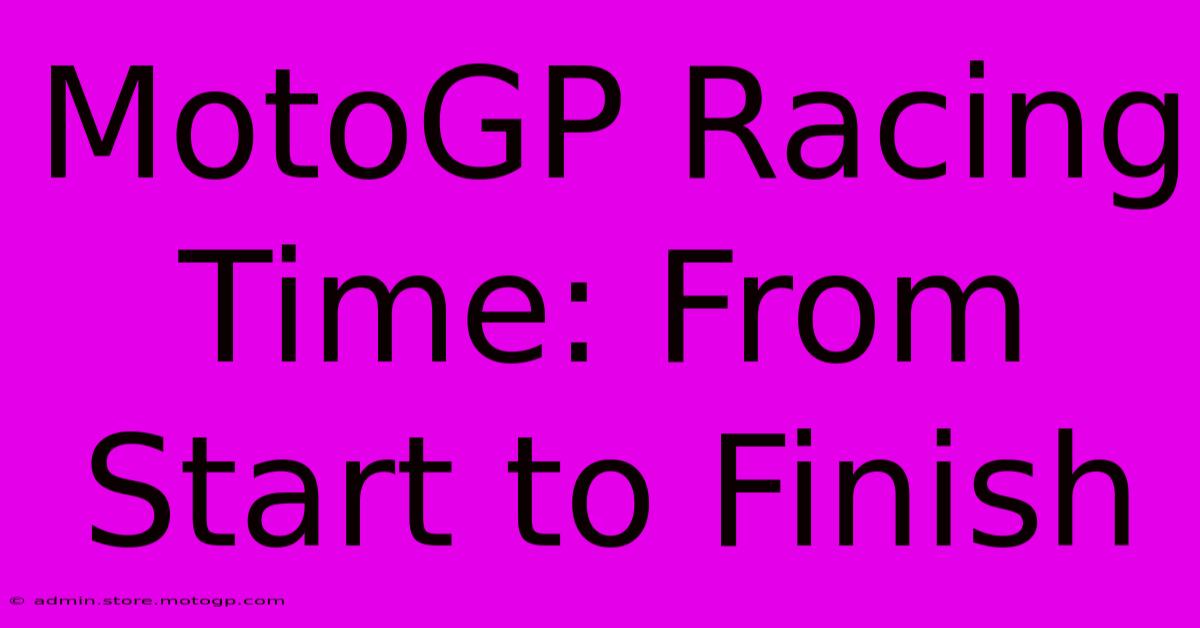MotoGP Racing Time: From Start To Finish

Table of Contents
MotoGP Racing Time: From Start to Finish
MotoGP, the pinnacle of motorcycle racing, is a spectacle of speed, skill, and strategy. But beyond the thrilling overtakes and breathtaking speeds, there's a fascinating element of precise timing that governs every aspect of a race weekend, from the first practice session to the checkered flag. This article delves into the intricacies of time in MotoGP, exploring the various phases and their significance.
The Practice Sessions: Laying the Foundation
The weekend begins with free practice sessions (FP1, FP2, FP3, and FP4 in some races), crucial for riders to acclimate to the track, test different setups, and find the optimal racing line. These sessions aren't just about speed; they are about data collection. Teams meticulously analyze lap times, sector times, and braking points to refine bike settings and strategy. Consistent lap times during practice are a strong indicator of a rider's readiness for qualifying.
Understanding the Timing Data
The timing screens and telemetry data provide a wealth of information. We see the best lap times, the average lap times, and the times achieved in each sector of the track. This allows teams to pinpoint areas where improvements can be made – perhaps a smoother corner entry or a more aggressive exit. The consistency of lap times is equally important, indicating a stable and predictable performance. An erratic performance suggests potential problems that need addressing before qualifying.
Qualifying: The Battle for Pole Position
Qualifying is a high-pressure, short burst of intense speed. The goal? To secure the coveted pole position – the best starting position on the grid. The qualifying format, while subject to changes year-to-year, generally involves several sessions, each whittling down the field to the fastest riders. Every hundredth of a second counts in the pursuit of pole, representing the difference between a strategic advantage and a frustrating fight through the pack.
The Importance of Qualifying Time
A good qualifying time translates directly into race day strategy. Starting from the front row offers a significant advantage, minimizing the risk of collisions and allowing riders to dictate the pace of the race. Conversely, a poor qualifying performance often means a tougher race, requiring more overtaking maneuvers and increased risk. The difference between starting first and starting tenth can mean several seconds lost at the start, making overtaking crucial and potentially exhausting.
The Race: A Symphony of Timing
The race itself is a complex interplay of pace, strategy, and timing. Riders constantly monitor their lap times, checking their position relative to their competitors. Race pace – maintaining a consistently fast speed throughout the race – is key to success. Managing tire wear and fuel consumption adds another layer of complexity to the timing equation.
Pit Stops and Their Timing
In certain MotoGP races, pit stops for tire changes are mandatory. The timing of these pit stops is critical. A perfectly timed pit stop can minimize time loss, but a poorly timed one can severely impact race results. Teams use sophisticated strategies based on tire degradation, fuel consumption, and race conditions to determine the optimal pit stop window.
Beyond the Race: Analyzing the Time
Even after the checkered flag, the work continues. Teams pore over the race data, analyzing lap times, sector times, braking points, and acceleration data to identify areas for improvement. This continuous analysis ensures that teams are constantly striving for optimal performance and pushing the boundaries of speed and efficiency. This data-driven approach is what makes MotoGP a sport that demands both skill and precise timing.
In conclusion, timing is an essential element of MotoGP racing, extending from the initial practice sessions to post-race analysis. Understanding and mastering the nuances of time is crucial for both riders and teams aiming for success on the world's premier motorcycle racing stage.

Thank you for visiting our website wich cover about MotoGP Racing Time: From Start To Finish. We hope the information provided has been useful to you. Feel free to contact us if you have any questions or need further assistance. See you next time and dont miss to bookmark.
Featured Posts
-
The Downforce Dilemma Moto Gp Aero Debates
Feb 19, 2025
-
Cota Parking The Austin Map You Cant Miss
Feb 19, 2025
-
Cota Parking Pass The Easiest Way To Enjoy The Race
Feb 19, 2025
-
Circuit Of The Americas Lot F Parking Perks And Pitfalls
Feb 19, 2025
-
Circuit Of The Americas Indulge In Vip Hospitality
Feb 19, 2025
